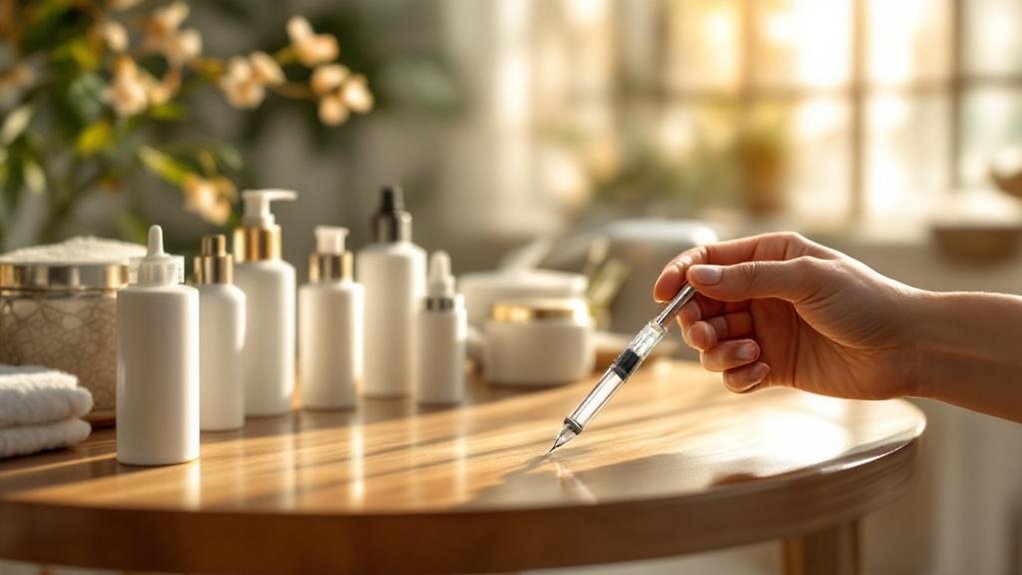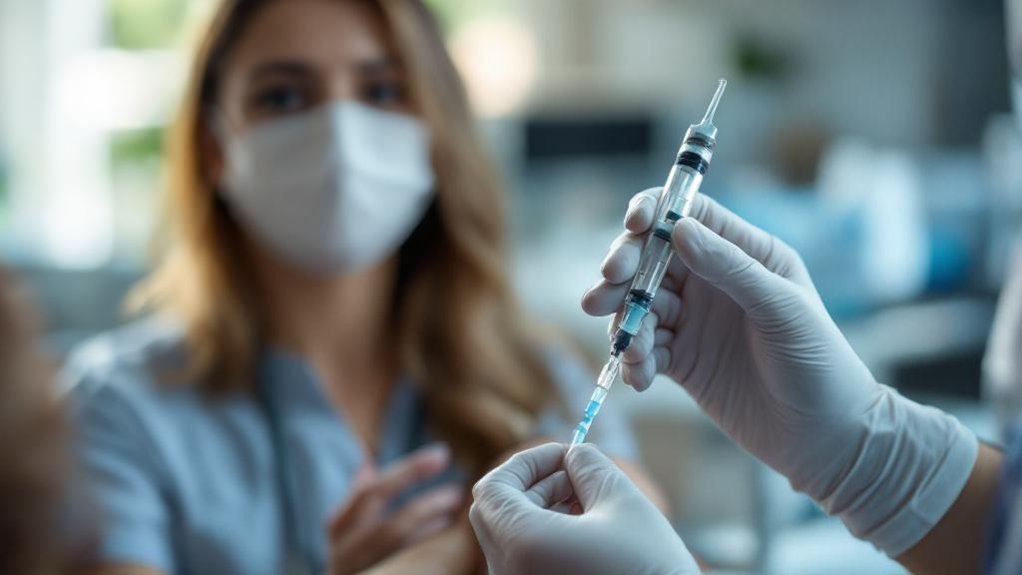Posted by: Skin And Cancer Institute in Medical Dermatology

We can’t assume non surgical treatments are universally safe despite their popularity. Research reveals dermal fillers carry a 42% complication rate, while botulinum toxin shows 15% adverse events. Serious risks include vascular occlusion, tissue necrosis, nerve damage, and infections requiring antibiotic intervention. Safety standards vary dramatically between regions, with some operating under minimal oversight while others enforce strict protocols. Economic pressures often prioritize cost over safety, creating systemic vulnerabilities that extend far beyond individual treatment rooms.
While many patients believe non surgical treatment is a straightforward solution, it is vital to understand the risks involved. Non surgical treatment procedures are not without complications, and education about these risks is crucial for informed decision-making.
Key Takeaways
- Non-surgical procedures carry real risks including vascular occlusion, infection, allergic reactions, nerve damage, and tissue necrosis.
- Dermal fillers cause 42% of complications while botulinum toxin A has a 15% complication rate despite widespread use.
- Safety standards vary dramatically by region, with stricter regulations in Dubai and EU showing fewer adverse events.
- Economic pressures often prioritize cost over safety, leading clinicians to overlook contraindications in high-volume practices.
- Over 94% of patients report dismissed symptoms, creating communication barriers that can worsen treatment outcomes.
The Hidden Complications of Popular Non Surgical Treatment Procedures

While non-surgical dermatological procedures are often marketed as “safer alternatives” to traditional surgery, we’ve observed that patients frequently underestimate their potential complications. These hidden risks include vascular occlusion—though rare at 0.001% of filler injections—which can cause devastating tissue necrosis, particularly in high-risk zones like the glabella and alar groove. We’ve documented infection risks at injection sites despite sterile techniques, requiring antibiotic intervention. Allergic reactions, while uncommon with hyaluronic acid fillers, still present as angioedema or systemic symptoms. Post-procedural inflammation including bruising, erythema, and swelling represents expected responses, yet combined treatments amplify injury potential. Nerve damage complications may result in temporary numbness or altered sensation in treated areas. Thorough patient education guarantees our community understands these realities before proceeding with treatment decisions.
Regional Variations in Safety Standards and Regulation
As patients explore their options, understanding the implications of non surgical treatment versus traditional methods can lead to more informed choices and better safety outcomes.
Although non surgical treatment procedures share similar techniques globally, we’ve identified significant disparities in regulatory frameworks that directly impact patient safety outcomes. These regulatory disparities create an uneven landscape where patient protection varies dramatically by location.
Many individuals turn to non surgical treatment as an alternative to invasive surgery, but hidden risks may outweigh benefits. Comprehensive discussions about the potential outcomes of non surgical treatment are important to ensure patient safety.
Dubai maintains extensive licensing requirements with mandatory facility standards, detailed clinical policies, and robust safety protocols. The EU enforces unified standards through EN 16844, requiring risk management systems and adverse event reporting. Conversely, the UK operates under self-regulation with limited oversight—botulinum toxin requires no prescription, and dermal fillers remain largely unregulated.
The prevalence of non surgical treatment options means patients often overlook the importance of understanding the possible complications associated with these procedures. Each type of non surgical treatment carries its specific risks that must be considered.
It is essential to recognize that the landscape of non surgical treatment varies based on regulations and safety standards, which can impact patient outcomes significantly.
Singapore focuses on medical device oversight but lacks aesthetic-specific protections. We’ve observed that regions with stricter safety protocols demonstrate fewer adverse events, while areas with minimal regulation report increased complications including infection, scarring, and muscle weakness. Countries like Malaysia, Thailand, and South Korea operate without dedicated aesthetic legislation, relying instead on general medical laws that fail to address the unique challenges of cosmetic procedures.
Cost Savings vs. Safety Trade-offs in Medical Decision Making

When healthcare decisions increasingly pivot on cost considerations, we’re witnessing a concerning shift where economic pressures directly influence treatment safety outcomes. Cost effectiveness often drives patient prioritization toward procedures like dermal fillers, which account for 42% of complications despite their popularity and accessibility. We’re seeing botulinum toxin A maintain widespread use purely due to affordability, even with documented 15% complication rates.
Patients are often drawn to non surgical treatment due to the promise of quick recovery; however, the potential for complications should remain a priority in discussions with healthcare providers.
Understanding the risks associated with non surgical treatment can empower patients to take an active role in their care and advocate for their safety throughout the decision-making process.
The choice of non surgical treatment should always be made with a comprehensive understanding of both the benefits and the potential risks involved.
Informed consent before any non surgical treatment is crucial; patients need to be fully aware of what to expect from their chosen procedure.
The pressure extends beyond individual choices. Clinicians face systemic demands favoring efficiency over thorough evaluations, potentially overlooking contraindications in high-volume practices. Insurance reimbursement disparities further incentivize cheaper procedures regardless of their complication profiles. While higher-safety products like Juvéderm demonstrate superior outcomes, they’re frequently priced beyond reach for budget-conscious patients, creating a two-tiered safety system we must address.
Ultimately, patients must weigh their options carefully when considering non surgical treatment, ensuring they have sufficient information to navigate the decision-making process effectively.
The geographic dimension of these cost-safety trade-offs becomes apparent when examining medical tourism patterns, where Asia reports 34% of global complications as patients seek more affordable treatment options abroad.
Treatment-Specific Risk Profiles: From Low to High-Risk Options
As we examine treatment-specific risk profiles across non-surgical interventions, we’re confronted with a stark reality: safety varies dramatically depending on the procedure chosen. Our risk assessment reveals dermal fillers account for 42% of complications, while thread lifts demonstrate concerning extrusion rates. Treatment comparison data shows botulinum toxin A maintains a moderate 15% complication rate with mainly mild effects.
We’ve identified safer alternatives that align with evidence-based practice. Prabotulinumtoxin A demonstrates >85% safety probability, while high-viscosity Juvéderm formulations minimize adverse events. Profhilo and microneedling radiofrequency offer robust safety profiles for rejuvenation. Patient demographics significantly influence treatment selection, as racial differences in aesthetic goals affect both procedure choice and associated risk profiles.
However, emerging risks demand our attention. Unregulated exosome therapies outpace safety validation, creating unknown hazards. We must prioritize proven interventions over experimental treatments lacking thorough clinical data.
Global Patient Safety Crisis: Beyond the Treatment Room

While we’ve mapped treatment-specific risks within controlled clinical environments, a broader crisis threatens patient safety across global healthcare systems. Over 94% of patients report dismissed symptoms, creating communication barriers that undermine patient empowerment and lead to medical gaslighting. Time constraints reduce clinician empathy, while biases against age, weight, or mental health drive diagnostic errors.
We’re witnessing increased cybersecurity threats disrupting operations, counterfeit medications entering supply chains, and inadequate AI governance creating integration errors. The WHO reports that while 74% of countries adopt medication safety challenges, only 33% maintain national safety plans. These systemic vulnerabilities affect us all—from ransomware attacks compromising our data to workforce shortages limiting competency building in underserved regions, demanding extensive reform. Veterans face unique healthcare challenges requiring specialized approaches that address both physical and psychological health needs.
Frequently Asked Questions
How Long Should I Wait Between Different Non Surgical Treatments?
We recommend specific treatment intervals based on procedure type and your individual recovery time. Botox requires 3-4 months between sessions, while CoolSculpting needs 30 days minimum, and laser treatments require 4-8 weeks for ideal healing.
Can I Combine Multiple Non-Surgical Procedures in One Session Safely?
We can safely combine certain non-surgical procedures in one session, though safety concerns require careful evaluation. Procedure combinations depend on treatment types, your medical history, and our thorough risk assessment protocols.
What Medications Should I Stop Before Non-Surgical Cosmetic Treatments?
We’ll review your complete medication list together, focusing on blood thinners like Plavix and Coumadin, plus herbal supplements including ginkgo biloba and vitamin E, typically discontinuing them seven days pre-treatment.
How Do I Verify My Provider’s Credentials for Non-Surgical Procedures?
In conclusion, understanding the complexities of non surgical treatment is key to achieving optimal outcomes while minimizing risks.
We recommend verifying provider qualifications through ABMS Certification Matters for board certification status and state medical board portals for licensing. Credential verification guarantees you’re receiving treatments from properly trained dermatology professionals.
What Insurance Coverage Exists for Complications From Cosmetic Non-Surgical Treatments?
Most insurance policies exclude cosmetic complications coverage. We recommend verifying your provider’s accreditation and considering specialized complication insurance with specific coverage limits, as standard policies typically deny claims for elective aesthetic procedures.
Conclusion
We’ve demonstrated that non-surgical treatments carry genuine risks requiring careful evaluation. Our evidence-based approach guarantees we’re transparent about complications, regulatory variations, and cost-versus-safety considerations inherent in these procedures. Through extensive risk stratification and adherence to rigorous protocols, we minimize adverse outcomes while maximizing therapeutic benefits. Your safety remains our clinical priority—we’ll continue providing thorough assessments, appropriate patient selection, and meticulous technique to guarantee ideal treatment outcomes across all non-surgical interventions.